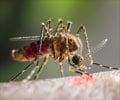A 'killer' virus, believed to be the dreaded strain called Japanese encephalitis, has left 12 dead over the past three days
A 'killer' virus, believed to be the dreaded strain called Japanese encephalitis, has left 12 dead over the past three days, raising the toll to 336 in the past nine months in different parts of the state. Local people believe that it is another onslaught of the dreaded Japanese encephalitis stalking them, but health officials and experts ruled out the possibility. Extensive immunization was carried out in the region to prevent the spread of the disease, they said.
Experts from three leading scientific institutions - the National Institute of Virology, Pune; the National Institute of Communicable Diseases, New Delhi; and the Centre for Research and Medical Entemology, Madurai - have not been able to detect the virus yet.The worst affected areas are Gorakhpur, Kushinagar, and Maharajganj in eastern Uttar Pradesh, and Saharanpur and Muzaffarnagar in western part of the state.
State principal health secretary A.K. Misra and director general (health) L.B. Prasad visited the worst hit districts Friday to take stock of the situation. However, they were clueless about the virus.
"We have directed the local officials to enhance their surveillance and also create greater awareness among people," Misra told IANS. "Since it is widely believed that the virus is water borne and proliferates in unhygienic conditions, arrangements have been made for fogging in all villages and towns in the region," he added.
Meanwhile, a high-level meeting of experts was convened on Oct 23 to plan a strategy to tackle the problem. According to the Gorakhpur Medical College hospital records, as many as 1600 people were admitted in the hospital after being affected by the mysterious virus since January.
"Though some of them were adults, the larger chunk of the affected people were children," said K.P. Kushwaha, who has been heading a panel of the hospital for combating the virus.
Advertisement
"From my experience, I could say that the virus is a new kind of encephalitis," he added.
Advertisement
LIN/C










